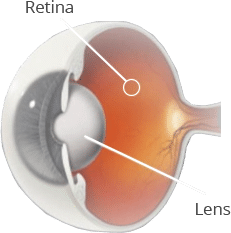CATARACT
What is Cataract?
A cataract occurs when the lens inside the eye becomes cloudy, leading to blurred and decreased field of vision. Contrast and colour perception may also be affected in the early stages.


Causes
The function of the lens inside the eye is to focus light onto the retina, providing clear vision and adjustment for objects far away and up close.
The lens is made up mainly of water and protein. As we age, protein in the lens can often clump together and then begin to cloud a small area of the lens. Over time, this clouding grows and gradually worsens the vision of the patient. Researchers have yet to identify exactly why this happens as we get older.

It is one of the most common causes of blindness in patients over 40 and can develop in both eyes. The clouding or misting of the lens prevents light from passing through the eye and images from being focused properly onto the retina. Vision loss is gradual as the cataract grows denser, until eventually, all light is obstructed.
Types of cataracts
Symptoms can vary according to the specific type of cataract. Different cataract types include:
1 Nuclear cataract
Associated with ageing, and forms deep in the nucleus (centre) of the lens.
2 Posterior sub-capsular
Associated with people who have diabetes or have taken high doses of steroids. It forms at the back of the lens.
3 Cortical cataract
This occurs in the lens cortex and is characterised by peripheral clouding which works its way towards the centre of the lens.
Symptoms & signs
The symptoms usually start out mild, and initially have little effect on your quality of life.
The most common indicators of a cataract developing include blurred or misty vision. Other symptoms include:
- Finding lights too bright or too glaring, either from lamps, the sun or car headlights
- Finding it harder to see in dim light
- Experiencing a brown or yellow tinge to your vision
- Finding colours looking faded and less clear
- Experiencing double vision
- Seeing a circle of light (haloes) around bright lights
Cataracts are usually not painful and rarely cause irritation or redness, although in advanced cases, they may be associated with raised intraocular pressure leading to symptoms of pain, nausea and vomiting.
To learn more about Cataract surgery in Singapore, click the link below.
Who is affected?
The condition can occur at any age but it is more likely to affect older patients.
In rare instances, childhood cataracts can develop in babies and young children. There are a number of factors which may contribute to the development of cataracts. These include:
- Family history
- Smoking
- Obesity
- Significant alcohol consumption
- Certain health conditions like diabetes, hypertension and high myopia
- Prolonged exposure to ultraviolet radiation from sunlight and other sources
- Previous eye injury, inflammation or surgery
- The use of corticosteroid medications, statin medicines or hormone replacement therapy